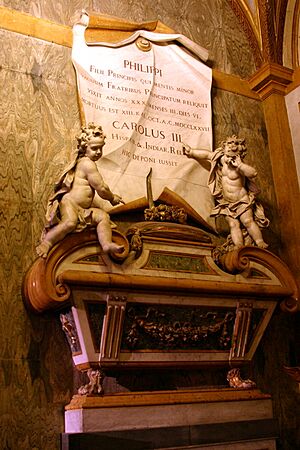Infante Philip, Duke of Calabria facts for kids
Quick facts for kids Infante Philip |
|||||
|---|---|---|---|---|---|
| Duke of Calabria | |||||

Portrait by Francesco Liani
|
|||||
| Born | 13 June 1747 Palace of Portici, Portici, Kingdom of Naples |
||||
| Died | 19 September 1777 (aged 30) Palace of Portici, Portici, Kingdom of Naples |
||||
| Burial | Basilica of Santa Chiara, Naples | ||||
|
|||||
| House | Bourbons of Naples | ||||
| Father | Charles VII & V of Naples & Sicily | ||||
| Mother | Maria Amalia of Saxony | ||||
Philip of Naples and Sicily (born June 13, 1747 – died September 19, 1777) was a prince known as the "Duke of Calabria" and an Infante of Spain. He was the oldest son of Charles III of Spain, who was a powerful king. Philip was supposed to inherit the thrones of Spain and Naples. However, he was not able to become king because of his health challenges. His younger brothers, Charles IV of Spain and Ferdinand I of the Two Sicilies, took his place in the line to the throne. When his father became King of Spain in 1759, Philip stayed in Naples. He lived there until he passed away from smallpox at the age of 30.
Contents
Early Life of Prince Philip
Philip was born at the Royal Palace of Portici in the Kingdom of Naples. He was the sixth child and first son of Charles VII and V, who was then the King of Naples and Sicily. His mother was Maria Amalia of Saxony. His birth was a very happy event for his parents. This was because they had five daughters before him, and three of them had died when they were very young.
The young prince was given a long name: Filippo Antonio Gennaro Pasquale Francesco de Paula. He was named after his grandfather, King Philip V of Spain, who had died the year before Philip was born. His godparents were his aunt and uncle, King Ferdinand VI of Spain and Barbara of Portugal.
Health Challenges from Birth
As the oldest son, Philip was the heir apparent, meaning he was next in line to become king. He was given the title of Duke of Calabria. This was a special title for the person who would inherit the throne of Naples.
Even though he seemed healthy at birth, it soon became clear that Philip had some health problems. He had epileptic fits, which are sudden bursts of electrical activity in the brain that can cause seizures. As he grew older, it was clear he had disabilities. One person who saw him said he had "a great heaviness of head, which makes him gloomy and ill-humored."
In 1754, when Philip was seven years old, an ambassador from Sardinia wrote about him. He said that the prince "does not appear to enjoy good health." He also mentioned that Philip "does not speak, and that he can scarcely utter a word."
His parents tried to keep his health problems a secret from the public. They made sure he appeared at royal events as if nothing was wrong. Until he was seven, Philip stayed with his sisters and younger brothers. In 1755, he and his brother Charles began to be taught by the Prince of San Nicandro.
Why Philip Could Not Be King
In 1759, a big change happened. Philip's half-uncle, King Ferdinand VI of Spain, died. This meant that Philip's father, Charles III, had to go to Spain to become the new King of Spain.
Before leaving Naples, King Charles III had to decide who would rule Naples and Sicily. He needed to give up his thrones there to one of his sons. A group of important officials, judges, and six doctors examined Prince Philip. He was twelve years old at the time. They needed to see if he was able to rule a kingdom.
The prince was watched closely for two weeks. After this, the group decided that his mental health challenges made him unable to govern. Because of this, he was removed from the line of succession for both thrones. His younger brothers, Charles and Ferdinand, then became the next in line.
Philip stayed in Naples, away from the royal court. He lived at the palaces of Capodimonte and the new Palace of Caserta. His brother Ferdinand would visit him often and was very kind to him.
Philip's Later Years
According to William Hamilton, who was the British Ambassador to Naples, Prince Philip was treated with great care. He had special helpers called "chamberlains" who were always with him. They watched him closely to make sure he was safe and well.
On certain days, Philip was allowed to hold a special kind of "Court." This meant that foreign ambassadors would visit his rooms to show their respect. His favorite game was to have his helpers hold up his hand while they put many gloves on it, one larger than the other, sometimes up to fifteen or sixteen gloves!
In September 1777, Prince Philip became sick with smallpox, a serious disease. The King and Queen were worried about catching the illness, so they left for Caserta. Philip died at the Palace of Portici in Naples when he was 30 years old. He was buried at the Basilica of Santa Chiara in Naples.
See also
 In Spanish: Felipe Antonio de Borbón para niños
In Spanish: Felipe Antonio de Borbón para niños


